Roscoffensis I/O: on exploring our becoming Homo Photosyntheticus. Artistic research in the footsteps of the Roscoff worm and Lynn Margulis
Published 8 December 2024 by Ewen Chardronnet
The exhibition “Roscoffensis I/O” by Miha Godec and the Roscosmoe Lab was presented at Osmo/za gallery in Ljubljana on November 27-30, 2024 as part of the More-Than-Planet expedition. With Roscoffensis I/O, Miha Godec and the Roscosmoe Lab invited visitors to examine animal-plant-machine interrelationships, and to reflect on the future of terrestrial life forms here and in outer space. Curatorial essay.
The geographical point of departure for this research is Roscoff, in Finistère, on the westernmost tip of Brittany, France. It’s here that, ten years ago, I first met Dr. Xavier Bailly, biologist at the Roscoff Marine Station (CNRS – Sorbonne University) (1). In his laboratory and on the foreshore of the region’s beaches, Bailly works extensively on the marine model Symsagittifera Roscoffensis, a small marine flatworm named after the town where it was first described over a hundred years ago. This tiny green worm ingests but does not digest its algal partner, preserving it in its tissues to feed on its photosynthetic activity. To meet the Roscoff worm is also to meet Lynn Margulis, for she regularly cited it as an iconoclastic biological model to argue her theory of endosymbiotic relationships as a general driver of evolution. In 1986, in the speculative pages of Microcosmos, she and her son Dorion Sagan used the Roscoff worm as an example of photosymbiosis that could inspire the human species to become Homo Photosyntheticus (2). And in 1998, Margulis dedicated the first pages of Symbiotic Planet to the Roscoff worm.
“In Brittany, on the northwest coast of France, and along beaches bordering the English Channel is found a strange sort of ‘seaweed’ that is not seaweed at all. From a distance it is a bright green patch on the sand. The patches slosh around, shimmering in shallow puddles. When you pick up the green water and let it slip through your fingers you notice gooey ribbons much like seaweed. A small hand lens or low-power microscope reveals that what looked like seaweed are really green worms. These masses of sunbathing green worms, unlike any seaweed, burrow into the sand and effectively disappear. They were first described in the 1920s by an Englishman, J. Keeble, who spent his summers at Roscoff. Keeble called them ‘plant-animals’ and diagrammed them splendidly in the color frontispiece of his book, Plant-Animals. The flatworms of the species Convoluta roscoffensis are all green because their tissues are packed with Platymonas cells; as the worms are translucent, the green color of Platymonas, photosynthesizing algae, shows through. Although lovely, the green algae are not merely decorative: they live and grow, die and reproduce, inside the bodies of the worms. Indeed they produce the food that the worms ‘eat.’ The mouths of the worms become superfluous and do not function after the worm larvae hatch. Sunlight reaches the algae inside their mobile greenhouses and allows them to grow and feed themselves as they leak photosynthetic products and feed their hosts from the inside. The symbiotic algae even do the worm a waste management favor: they recycle the worm’s uric acid waste into nutrients for themselves. Algae and worm make a miniature ecosystem swimming in the sun. Indeed, these two beings are so intimate that it is difficult, without very high-power microscopy, to say where the animal ends and the algae begin.” (3)
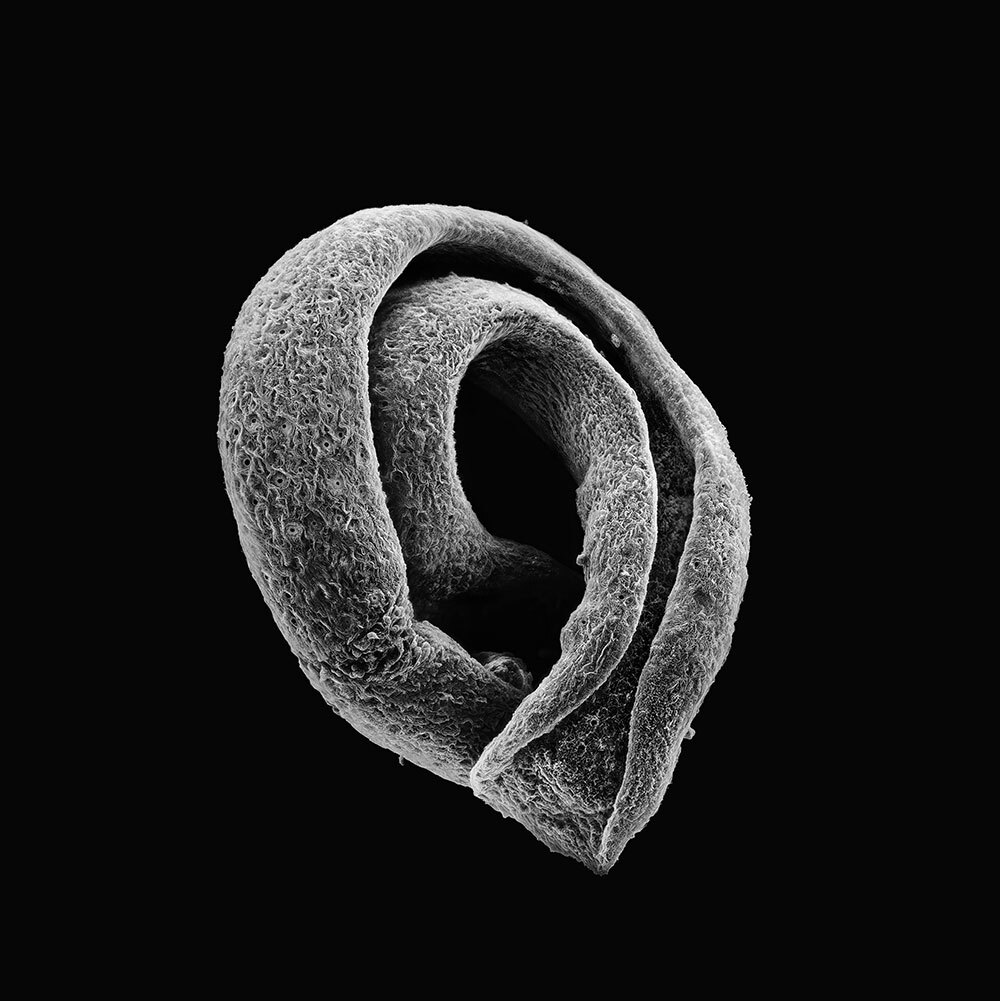
Although Margulis’s endosymbiotic theory is now widely accepted, the biologist had to fight long and hard to defend her ideas. In her now-famous article “On the Origin of Mitosing Cells”, published in 1967 in the Journal of Theoretical Biology, Margulis revived the long-dormant idea of an endosymbiotic origin of mitochondria (4) and plastids (5) from bacterial ancestors, an idea that had almost sunk into oblivion after having given rise to curious and stimulating research between the 1880s and 1920s (6). We will not recount in detail the fascinating meanders in the development of endosymbiotic theory since its first sketches 150 years ago. Through her research and her books, Margulis largely traced the path of this work, constantly pushing for the translation and republication of forgotten studies on the symbioses and endosymbioses that may have developed from the 1860s to the 1920s. She reconnected the dots from Heinrich Anton de Bary’s definition of symbiosis in 1877, to chloroplasts by Andreas Schimper (1883), to Constantin Merejkovski’s symbiogenesis (1905, 1910, 1920), right up to the Soviet Union’s publication in 1924 of Symbiogenesis: A New Principle of Evolution by Boris Kozo-Polyansky, a work that, as she underlines, would mark a point of historical discontinuity. Although Kozo-Polyansky synthesized in terms of Darwinian evolution decades of speculation on symbiogenesis by numerous scientists of many nationalities, he was ridiculed and discredited, and his writings did not cross geographical and political boundaries in his time (7). Margulis was not aware of Kozo-Polyansky’s work until quite late, and it was not until 2009 that she published a complete translation of the book.
But let’s go back to the years when Henri Lacaze-Duthiers founded the Roscoff Marine Station (1872), and the role played by the Roscoff worm in the development of a symbiotic theory of evolution.
Emerging symbiotic theory and describing the Roscoff worm
Under Carl Linnaeus and up until the 19th century, certain so-called lower animal species were still placed in a special category called “Zoophytes” (etymologically, animal-plants). In Gottfried Treviranus’s classification published in 1802, he distinguished two classes: the Zoophyta class, including corals, jellyfish, sea anemones, hydras, sea urchins and starfish, and the Phytozoa class for “plant-animals” including fungi, lichens, mosses, ferns and water plants, filamentous algae and wrack, etc. Things gradually evolved in the 19th century, however: Christian Ehrenberg, who coined the word bacterium in 1838 (8), examined euglenes, diatoms and radiolarians and identified corals; Henri Lacaze-Duthiers studied corals in Algeria and published a “natural history” of them in 1864 (9); Addison Verrill created the phylum of cnidarians (corals, anemones, jellyfish, etc.) in 1865; and Ernst Haeckel proposed the kingdom of protists in 1866 to categorize unclassifiable species with both animal and plant characteristics. Also in 1866, Heinrich Anton de Bary from the University of Halle in Germany described the dual fungus-algae nature of lichen (10). The Swiss Simon Schwendener (11) asserts the same thing in several publications, as do the Russians Andrei Famintsyn and Ósip Baranetsky, who even claim to have cultivated algae outside the lichen thallus (12). However, Schwendener initially understood the relationship as one of parasitism, with the fungus being parasitic on the alga. De Bary was less categorical, and the notion was contested by some for several years, notably by Belgian zoologist Pierre-Joseph van Beneden, who in 1875 spoke of “mutualism”. In 1877, Albert-Bernhardt Frank, another lichen specialist from the University of Leipzig, proposed the word “symbiotismus” as a way out of a parasitic analysis that we might describe as anthropocentric: “Wherever there is a common internal or external habitat between two separate species, we must give a more extensive term; whatever role the two partners play, it is not yet taken into account. In any case, we’ll rely on ‘living together’ alone, and that’s why we can recommend referring to these cases as symbiotismus” (13). It wasn’t until 1878 that De Bary, in a now-famous presentation, proposed the general term “symbiosis” to describe different organisms living together. (14)
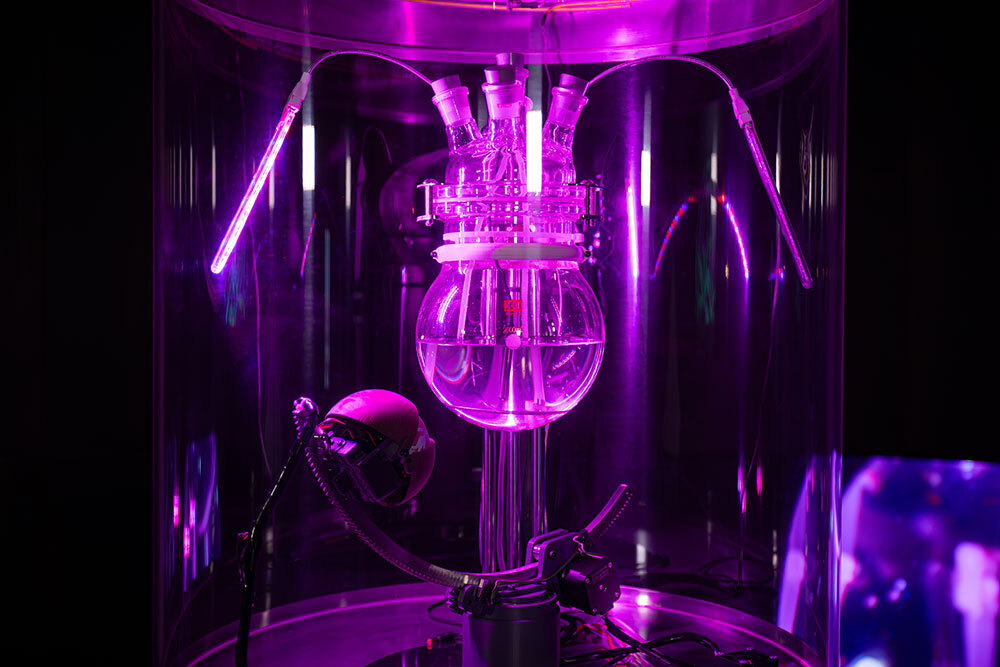
Like lichens (15), the strange new world of marine protists attracted the interest of young researchers in search of symbiosis. It was against this backdrop that, in the spring of 1879, the young Scottish botanist Patrick Geddes followed Thomas Huxley’s advice to travel to France, where he would meet Henri Lacaze-Duthiers. In Roscoff, Geddes worked on the species Symsagittifera Roscoffensis (then called Convoluta Schultzii), on which he published a study showing that this animal-alga produces oxygen. He noticed that Roscoff worms did not seem to feed. He presented his findings to the Royal Society in London: “The Planarians are little the worse after a 24 hours’ journey from Roscoff to Paris, and when placed in an aquarium they instantly betake themselves to the side next the window, and live there resting on the bottom or clinging to the side for four or five weeks without food. They certainly diminish considerably in size, yet I have little doubt that they go on decomposing CO2 and assimilating the carbon even in the dull winter daylight, for when kept in darkness they generally died much sooner.” (16)
Geddes also worked on anemones, which he described as animal-lichens. He then went to the Anton Dohrn Zoological Station in Naples – also founded in 1872, like the Roscoff Marine Station – and worked on hydras and other species in exchange with the young Berlin zoologist Karl Brandt. The two came to remarkable conclusions based on their observations, which were still influenced by their own definition of symbiosis as parasitism. In November 1881, Karl Brandt presented to the Berlin Physiological Society – and subsequently published in the Proceedings – his text “Symbiosis of Lower Animals with Algae”, in which he first mentioned animal-algal symbiosis: “However, while we find in lichens that true parasites (fungi) are associated with algae, we see in green and yellow animals a symbiosis of algae with animals that are used to an independent and self-sufficient lifestyle.” (17) In January 1882, Geddes published his paper “Further researches on animals containing chlorophyll” (18) in Nature, and also noted the central role of algae in terms of oxygenation and nutrition of animal tissues: “Such an association is far more complex than that of the fungus and alga in the lichen, and indeed stands unique in physiology as the highest development, not of parasitism, but of the reciprocity between the animal and vegetable kingdoms.” (19)
The description of the Roscoff worm, which marked those crucial years of the emergence of symbiotic theory in biology, has continued ever since. First it was Yves Delage (20) in 1886, who became director of the Roscoff Marine Station in 1901, followed by Ludwig von Graff (21), who corrected Geddes and Delage’s taxonomic errors in 1891, and finally Frederick Keeble, who in 1912 published with Cambridge University Press Plant-Animals, a detailed study of the symbiosis between the Roscoff worm and its micro-algae, a work that Margulis cites in Symbiotic Planet (22). Today, Dr. Xavier Bailly at the Roscoff Marine Station is working on mastering the worm’s life cycle. the Multicellular Marine Models laboratory at the Roscoff Marine Station.
Becoming algae
The Roscosmoe platform is an art-science initiative that welcomes or supports artists conducting research in the field of marine biology and biodiversity in partnership withIt gradually took shape beginning in 2013, when Ewen Chardronnet, as the program’s artistic director, invited artists Špela Petrič and Robertina Šebjanič to exhibit and discuss their art project Humalga at the Accès(s) Festival (23) in Pau, in southern France. Petrič and Šebjanič’s Humalga resonates directly with Margulis’s animalga S. Roscoffensis and Homo Photosyntheticus insofar as it proposes a constructed and alternative evolution of the human species at the crossroads of human and alga, an evolutionary destiny towards “humalga” by alternating a sexual (human) generation with an asexual (algal) generation. (24)
Following this first exhibition, Petrič and Šebjanič were invited to be artists-in-residency at the Roscoff Marine Station in April 2016, with the support of Ping association (25) in Nantes, the informal ArtLabo network (26), the Carasso Foundation (27) and the Multicellular Marine Models laboratory. This experience launched what was formalized in 2018 as the Roscosmoe platform, with the broader aim of hosting or supporting artists who are conducting research in the field of marine biology and biodiversity. Roscosmoe also supports the development of a space mission (28) to design a series of experiments and bioregenerative life-support systems, in order to assess the behavior of the Roscoff worm in a variety of gravitational environments, including weightless conditions. These themes converged through the residency of another Slovenian, Miha Turšič (29), from the PostGravityArt collective and their project Noordung::1995-2045 (30). Relationships were formed between Roscosmos, the European Space Agency (via its MELiSSA program, Micro-Ecological Life Support System Alternative) (31) and the French Centre National d’Etudes Spatiales (via the Federation / Open Space Makers initiative (32)). Meanwhile, this “space mission” incorporated a cultural component from the outset – not only would it aim to develop a module of scientific experiments around the Roscoff worm to be taken on board a space flight, it would also develop the terrestrial, cultural, philosophical and anthropological aspects of the project, around a “critical container” to be exhibited on Earth. A first presentation along these lines took place in 2018 at the Science Gallery in Dublin, in the exhibition “Life at the Edges” (33). That summer, PostGravityArt announced that it would be taking S. Roscoffensis on the Noordung::1995-2045 mission. (34)
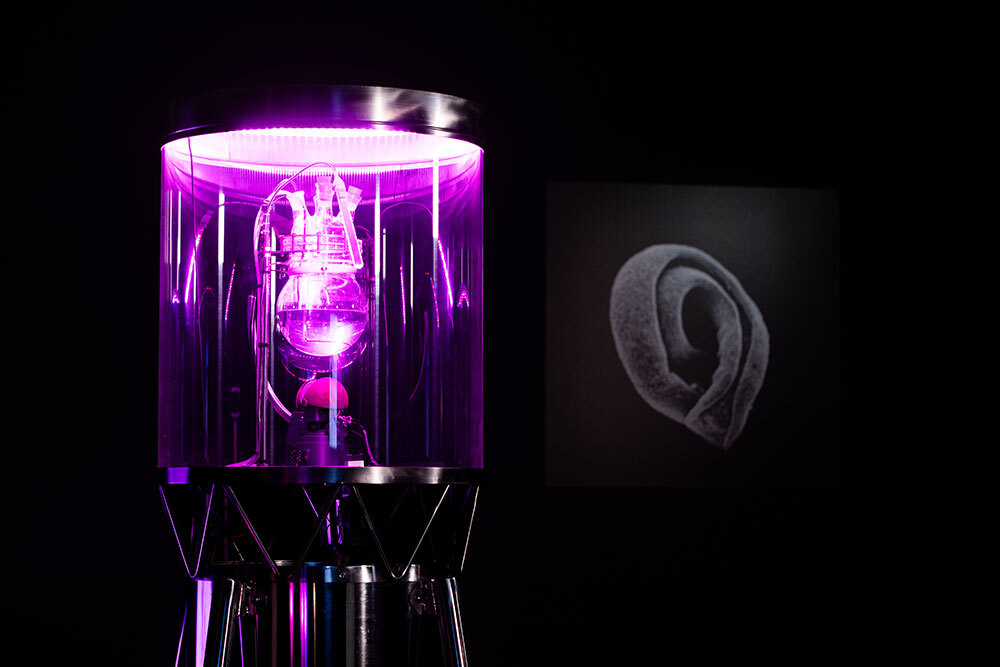
The global situation changed dramatically, however, with the outbreak of the Covid-19 pandemic, followed by the Russian invasion of Ukraine. Cooperation projects with Roscosmoe were largely compromised. Nonetheless, Ewen Chardronnet and Maya Minder, in collaboration with Sandra Bühler and Quentin Aurat, embarked on an artistic research into the many implications and speculative scenarios of “becoming Homo Photosyntheticus”. Green Open Food Evolution, an installation by Maya Minder (35), documentary essays and an interactive knowledge base (36), reflect this research work, and the Roscosmoe and Homo Photosyntheticus labs are supported by the European cooperation program More-Than-Planet (37). Finally, in 2023, Miha Godec’s Roscoffensis I/O installation gave the project a new impetus. Supported by the Roscosmoe Lab in 2023-2024, Roscoffensis I/O invites us to examine the interrelationships between plant-animals and machines, to reconsider our own relationship with the natural environment as a dynamic living system interacting with the anthropogenic technosphere, and more generally to reflect on anthropotechnics (38).
The installation establishes a new layer of symbiosis between the Symsagittifera roscoffensis colony and an anthropomorphized artificial intelligence system. This AI is embodied as a human eye (the observer) and operates on the Llama 3.2 machine learning model, which has been trained extensively on images of Roscoff worms. The AI’s primary function is to monitor the health of the organism by regulating environmental conditions such as light intensity and temperature. It dynamically adjusts these parameters to ensure optimal living conditions for the flatworms, effectively acting as a caretaker. The AI’s secondary objective is to influence the movement of the worm colony. Recognizing that Symsagittifera roscoffensis exhibits positive phototaxis—moving toward light—the AI can choose to activate either the left or right LED lights within the incubator. By making autonomous decisions about which light to illuminate, the AI encourages the worms to move in specific directions. This not only affects individual worms but can induce coordinated movement across the entire colony. The AI observes the outcomes of its actions, allowing it to learn and potentially refine its strategies for interacting with the organisms. Enhancing environmental realism, a vibrating speaker is installed in the incubator. This component introduces mechanical vibrations that simulate aspects of the flatworms’ natural marine habitat, adding another dimension of sensory input and biomimicry. The combination of controlled lighting and vibrational stimuli creates a multifaceted environment that closely mimics natural conditions, facilitating in-depth studies of organism behavior and AI-organism interactions. Roscoffensis I/O serves as a platform to investigate the autonomous survival capabilities of symbiotic organisms in isolated or extreme environments, such as those encountered during prolonged space travel. By interlinking plant, animal, and machine systems, the installation probes the boundaries of biological and technological integration. It underscores the complexity of natural interdependencies and invites viewers to reconsider their relationship with the environment, framing it as a dynamic and living system where technology and biology coalesce.
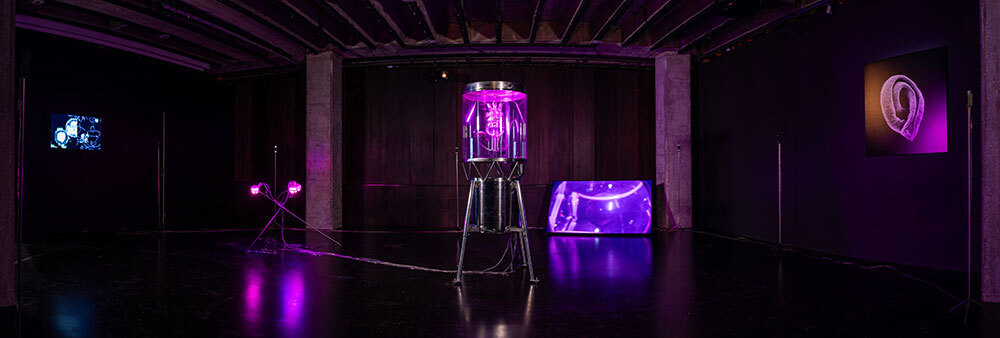
With Roscoffensis I/O also operating as an observation habitat for its long-term research objectives, the Roscosmoe Lab invites us to examine animal-plant-machine interrelationships in anthropotechnical constructs, and to reflect on the future of terrestrial life forms here and in outer space.
Queer outer space
Homo Photosyntheticus, inspired by S. Roscoffensis and imagined exploring the solar system, is also a germinal symbiogenesis between human and algae, a trans-plant queer becoming far from the transhumanist visions of augmented humans inherited from Julian Huxley or his neo-Darwinist thurifers. Here, we’re closer to a scenario such as in Petrič and Šebjanič’s Humalga than to a human species modified for the sole purpose of taking advantage of the photosynthetic functions of micro-algae. In the Humalga project, much like in a novel by Ursula Le Guin or Donna Haraway’s Camille Stories (39), the Humalga society gives rise to the emergence of a completely different civilization and social model.
The issue of biotechnology nevertheless opens up intriguing near-future scenarios. Many medical scientists are inspired by the symbiogenetic research of Margulis (40), and Chilean start-up Symbiox (41), which offers microalgae-based patches to treat burn victims through localized photosynthesis, doesn’t hesitate to use the Homo Photosyntheticus metaphor. In a short story published in December 2015, science fiction writer Kim Stanley Robinson imagines a near-future in which synthetic biologists have discovered “biobricks” that can be combined to create a synthetic chloroplast that can be injected under the skin like tattoos, recombining with human cells to achieve photosynthesis. After setting up a company called SunSkin, these biohackers decided to make their work open source, arguing that photosynthesis is a natural process: “Once they published the recipe, and the knowledge spread that human photosynthesis worked, the injection method as such became what you might call generic. […] when you photosynthesize sunlight you will be less hungry. You might also spend more of your day outdoors in the sun, that’s right, and subsequently decide that you didn’t need quite as much food or heating as before.” (42) Relating the trial, the short story focuses on the company’s responsibilities in the great agri-food and social collapse engendered by this biotechnology.
What are we to make of this utopian yet dystopian evolution towards a Homo Photosyntheticus? Interestingly, ESA’s MELiSSA program envisages circular systems for life on other planets, such as cultivating the cyanobacterium Limnospira indica, commonly known as spirulina, as an alternative source of food and oxygen. Sandra Ortega Ugalde, from the Environmental Control and Life Support Systems R&D division of the MELiSSA program in the Netherlands, answers the question of whether a spirulina-based diet would influence human physiology and the evolution of human colonies on Mars in the distant future: “We know that when astronauts stay in space for a long time, their microbiome changes, firstly because they are isolated and their exposure to micro-organisms is very limited, but also because the diet they ingest is not as diverse as the one we follow here on Earth, which has an impact on their microbiota. So we need to understand how to develop recipes to reconstitute the microbiome and maintain it in symbiosis (…) So I think that if we become, if we evolve into this species of Homo Photosyntheticus, it will be a great advantage for living in space and perhaps also on extraterrestrial planets such as Mars. And indeed, our own genetics will probably evolve by exposing us to hostile environments, so that, little by little, we may gain in genetic evolution, so that we may evolve into this Homo Photosyntheticus.” (43)
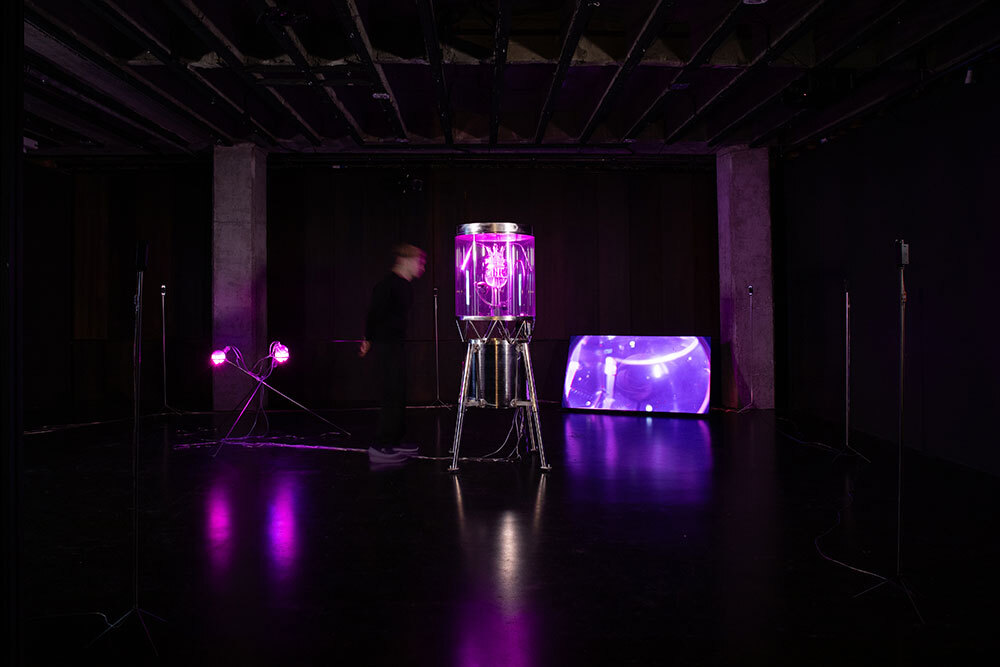
Symbiotic politics
All her life, Lynn Margulis pushed a symbiotic reading of evolution, based on assemblages and cooperation, to combat Darwin’s interpretation of “survival of the fittest” (with the disastrous interpretations we know about in the 20th century). To overcome the predicted disasters of the Anthropocene, we believe it is essential to promote our biological wisdom (44) to inspire a transformation of contemporary dysfunctional or maladapted societal systems that are chronically unable to protect human health and the environment.
It’s interesting to note that the use of the term symbiotic in the organization of social relations long predates its use in the field of biology. Indeed, as Frédéric Lordon pointed out in 2015 in his Imperium, Structures et affect des corps politiques (45), it can be found as early as the early 17th century in the work of jurist and political philosopher Johannes Althusius. Althusius is now considered a precursor of confederalism and anarchism, as Lordon points out (46). In his Politica methodice digesta et exemplis sacris et profanis illustrata, published in 1603, this Calvinist trained in civil and ecclesiastical law in Basel considers that “before being subjects of any sovereign, individuals are ‘symbiotes’. “It is the immanence of their common life that must be the starting point of all political thought” (47), Lordon emphasizes. In the first paragraph of his Politica, Althusius writes: “Politics is the art of associating (consociandi) men for the purpose of establishing, cultivating, and conserving social life among them. Whence it is called ‘symbiotics’. The subject matter of politics is therefore association (consociatio (48)), in which the symbiotes pledge themselves each to the other, by explicit or tacit agreement, to mutual communication of whatever is useful and necessary for the harmonious exercise of social life. The end of political ‘symbiotic’ man is holy, just, comfortable, and happy symbiosis, a life lacking nothing either necessary or useful.” (49)
Note that Althusius’s Politica methodice digesta was published 50 years before Thomas Hobbes’s Leviathan, or The Matter, Form, & Power of a Common-wealth Ecclesiasticall and Civill. It seems, however, that it was Hobbes’s persistent image of man as inherently violent in the state of nature, an individualist with an insatiable desire for power, which indirectly nurtured the “survival of the fittest” theory of his compatriots Herbert Spencer and Charles Darwin in the 19th century. Althusius has been largely ignored by history, and it is the hackneyed motto “Man is a wolf to Man” that endures.
Hobbes repeatedly proclaimed that he was the first to establish an authentic, scientifically founded doctrine of human affairs, the first to make a science of morality and politics. We prefer Althusius, who wrote: “It is evident that the commonwealth, or civil society, exists by nature, and that man is by nature a civil animal who strives eagerly for association.” (50) For Althusius, symbiosis (living together) implies more than mere common existence; it “indicates a quality of mutual sharing and communication” (51) without which society is not possible.
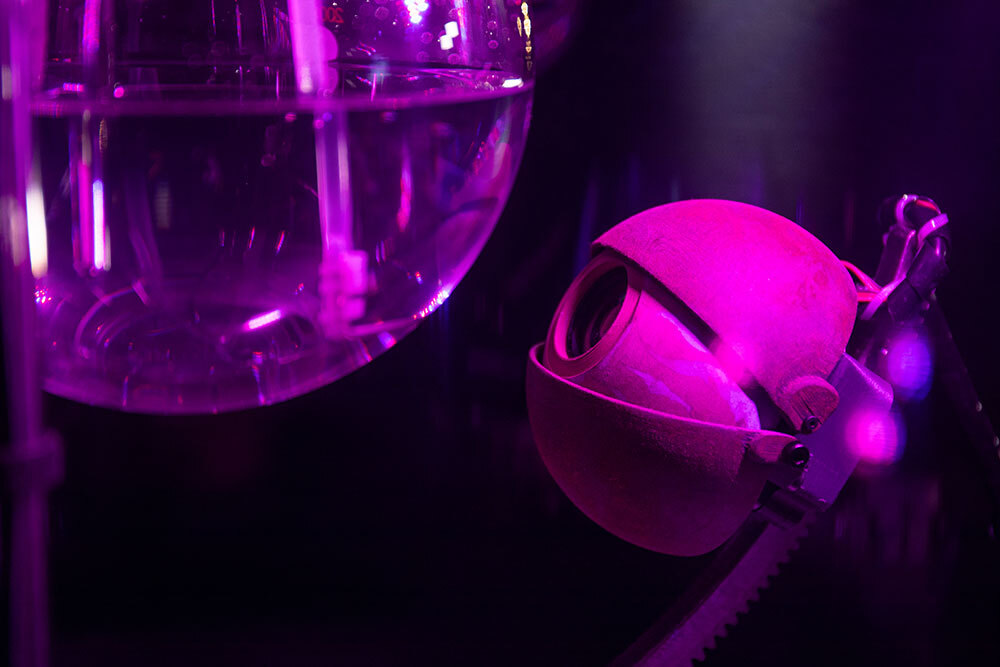
Margulis long fought to impose a vocabulary in line with her vision, but also to avoid anthropomorphizing living things. She would rebuke anyone who used the expression “mutual benefit” to talk about symbiotic relationships, pointing out that living things had nothing to do with these projections straight out of our economic visions. As Dr. Xavier Bailly points out, symbiotic relationships cannot be viewed in terms of profit and loss, but simply as functional imbalances between several species living in association. And, as he also points out, symbiotic relationships are not special cases, but apply to all living things – it’s no longer sufficient to talk about “symbiosis” in biology, especially as the term has been overused (52). As for becoming Homo Photosyntheticus, as Hideo Iwasaki, artist and professor specializing in the circadian rhythms of cyanobacteria at Tokyo’s Waseda University (53) once told us (54), we have to recognize that our bodies, almost our entire source of carbon, already comes from photosynthesis. So we already have a plant origin of our own. Poetically speaking, we are already plants. Homo Sapiens is a symbiont, both in terms of the endosymbiotic origin of its cells and its microbiome. And we can’t live without photosynthetic organisms: our very atmosphere is of photosynthetic origin. This reality is far more important than the desire to evolve into Homo Photosyntheticus, and that’s what we also aim to reveal in this work.
Notes
1. https://www.sb-roscoff.fr/fr/equipe-modeles-marins-multicellulaires
2. Lynn Margulis & Dorion Sagan, Microcosmos, University of California Press, 1986, 1997, pp.254, 255.
3.Lynn Margulis, Symbiotic Planet, Basic Books, 1998, p.
4. Mitochondria are part of a cell’s organelles, the site of cellular respiration, and their main function is to provide cells with the energy they need to ensure their survival and the functions they are supposed to perform.
5. The plastid is an organelle found in the cells of chlorophyllous eukaryotes (algae and plants).
6. Lynn Sagan, “On the origin of mitosing cells”, Journal of Theoretical Biology. 1967 Mar; 14 (3): 255-74. Lynn Margulis published this paper still under the name of her first husband, Carl Sagan. Indeed, when she proposed it in 1967, her paper was initially rejected several times, before finally finding a publisher. The theories that viewed cellular life as an edifice constructed from the action of multiple organelles were not then in the public eye; the unity of the cell and the complementarity of its activities were a more central preoccupation.
7. The next three decades would see the construction of a neo-Darwinian (“synthetic” according to Julian Huxley) theory of evolution in the West, and its prohibition – in particular of Gregor Mendel’s genetics – as a capitalist science under the Stalinist regime in favor of a pseudo-Lamarckian theory of environmental heredity promoted by the agronomist Trofim Lyssenko, with catastrophic consequences.
8. Christian Gottfried Ehrenberg, Die Infusionsthierchen als vollkommene Organismen, Verlag L. Loss, Leipzig, 1838, p. 75 (Research into the organization of infusorial animals).
9. Henri Lacaze-Duthiers, Histoire naturelle du corail, Baillère et fils, Académie impériale de médecine, 1864
10. Heinrich Anton de Bary, Morphologie und Physiologie der Pilze, Flechten und Myxomyceten, Verlag W. Engelmann, Leipzig, 1866 (Morphologie et Physiologie des Fungi, Lichens, et Myxomycètes).
11. Simon Schwendener, Untersuchungen über den Flechtenthallus, Beiträge zur wissenschaftliche Botanik, VI (1868), 195-207 & IDie Algentypen der Flechten Gonidien, Programm für die Rektorsfeier der Universität Basel, IV (1869), 1-42.
12. Olivier Perru, “Aux origines des recherches sur la symbiose vers 1868-1883”, Revue d’histoire des sciences, 2006/1 (Tome 59), pp.
13. Albert-Bernhardt Frank, “Über die biologischen Verhältnisse des Thallus einiger Krustenflechten” (On the biological conditions of the thallus of certain crustacean lichens), Beiträge zur Biologie der Pflanzen, II (1877), 123-200. Albert-Bernhardt Frank is also credited with coining the term mycorhiza in his 1885 article “Über die auf Wurzelsymbiose beruhende Ernährung gewisser Bäume durch unterirdische Pilze”.
14. “Die Erscheinung der Symbiose”, translated shortly afterwards into French as “De la symbiose”, Revue internationale des sciences, Paris, O. Doin, (1878-1879) , pp. 301-309.
15. To delve deeper into the fascinating world of lichens, we refer the reader to Vincent Zonca’s excellent book Lichens, Pour une résistance minimale, published in 2021 by Editions du Pommier, and in particular Book IV, Pour une pensée symbiotique.
16. Patrick Geddes, “Observations on the Physiology and Histology of Convoluta Schultzii”, Proceedings of the Royal Society of London, Vol. 28 (1878 – 1879), pp.
17. T. Krueger, “Concerning the cohabitation of animals and algae”, English translation of the original text of Karl Brandt’s 1881 presentation “Ueber das Zusammenleben von Thieren und Algen”, Symbiosis 71, 167-174 (2017).
18. Patrick Geddes, “Further researches on animals containing chlorophyll”, Nature, XXV (1882), 303-305.
19. Patrick Geddes, together with the Scottish zoologist John Arthur Thomson (1861-1933), later wrote the book The Evolution of Sex (1889), based entirely on Darwinism, but with an emphasis on cooperation as a fundamental factor in the evolution of complex organisms. His scientific career then took a turn, and he devoted himself to social evolution and urban planning, forging close ties with the geographer Elysée Reclus.
20. Yves Delage, “Etudes histologiques sur les planaires rhabdocoeles acoeles (Convoluta schultzii O. Sch.)”, Arch Zool Exp Gén, 4, 1886, p. 109-144.
21. Ludwig von Graff, Monographie der turbellarien (Vol. 1) W. Engelmann, 1882; L. von Graff, “Sur l’organisation des turbellariés acoeles”, Archives de Zoologie Expérimentale et Générale. Deuxième Série, Tome 9, 1891, p. 1-12
22. Ibid.
23. https://www.acces-s.org/
24. For more information: https://robertina.net/humalga and https://www.spelapetric.org/humalga
25. https://info.pingbase.net/1-camp/
26. https://artlabo.org/
27. https://www.fondationcarasso.org/
28. https://roscosmoe.org/space-mission/
29. It was also Miha Turšič who proposed the term Roscosmoe, taking its name from Roscoff and Cosmoe, in reference to the Cosmos of Kasimir Malevich’s Suprematism (Roscosmos is also the name of the Russian space agency).
30. https://roscosmoe.org/postgravityart/
31. https://www.melissafoundation.org
32. https://www.federation-openspacemakers.com
33. https://dublin.sciencegallery.com/life-at-the-edges-exhibits/roscosmoe
34. https://www.delo.si/sobotna-priloga/vesolje-je-bilo-narejeno-za-abstraktno-umetnost
35. https://roscosmoe.org/maya-minder
36. https://roscosmoe.org/homo-photosyntheticus
37. https://www.more-than-planet.eu/
38. Miha Godec’s Roscoffensis I/O was exhibited at Ljubljana City Gallery as part of a group exhibition titled “Co_Existence”, 2023. This new iteration follows a residency at the Multicellular Marine Models laboratory at the Roscoff Marine Station (France), organized by the Roscosmoe Lab as part of the More-Than-Planet program.
39. In Staying with the Trouble (Duke University press, 2016), Donna Haraway traces the lives of five Camilles from 2025 to 2425, a period during which the human population, which had risen from 8 to 10 billion, fell to 3 billion, and only half the species alive in 2015 still exist. Many humans have been modified to take on aspects of other species; in the case of the Camilles, this is the monarch butterfly.
40. Chávez, Myra N et al. “Photosymbiosis for Biomedical Applications”. Frontiers in Bioengineering and Biotechnology vol. 8 577204. Oct. 6, 2020. Interview available at: https://vimeo.com/562718091
41. https://www.symbiox.org/
42. Kim Stanley Robinson, Oral Argument, Tor Books, 2015.
43. In an interview of the Homo Photosyntheticus series, November 2021. Available at https://vimeo.com/766395650
44. During winter 2015 in Berlin and Estonia, a series of events on the theme of “Biological Wisdom and Social Transformation” and around soils, fermentation and mycology carried an inspiring word for us: https://www.facebook.com/groups/biologicalwisdom
45. Frédéric Lordon, Imperium, Structures et affect des corps politiques, La Fabrique, 2015.
46. Ibid. p.205.
47. Ibid. p. 203.
48. Consociationalism or concordance democracy has been studied since the 1960s, with the study of governance in countries such as Switzerland, Belgium and Lebanon.
49. The Politics of Johannes Althusius: An Abridged Translation of the Third Edition of Politica Methodice Digesta, atque Exemplis Sacris et Profanis Ilustrata, translation by Frederick S. Carney, Beacon Press, Boston, 1964, p.12.
50. Ibid. p. 20.
51. Althusius, Politica, 1.3, 1.6 and Althusius, Politica, 3.33. Quoted in Nico Vorster, “Symbiotic Anthropology and Politics in a Postmodern Age: Rethinking the Political Philosophy of Johannes Althusius (1557-1638)”, North-West University, South Africa, Renaissance and Reformation 38.2, Spring 2015, p.27.
52. After Joël de Rosnay’s symbiotic man, the cybiont, in the 1990s, we are now hearing talk of symbiotic economy, or symbiocracy. The term symbiocracy was already used in the 2000s to refer to an ideal political model for space colonies largely inspired by Margulis. In recent years, it has been used again on anarchist street stencils, as well as in corporate management.
53. https://hideo-iwasaki.com/
54. In an interview of the Homo Photosyntheticus series of May 2022. Available at https://vimeo.com/810873757
